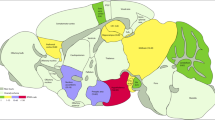Summary
Based on recent findings described in accompanying reports as well as on relevant observations in the literature we hypothesize that: (1) the fundamental elements in the mechanism of the formation of “dark” (argyrophilic) neurons are independent of the causative conditions including post-mortem or in vivo mechanical injuries and various in vivo pathometabolic processes such as blood recirculation following ischemia; (2) the causative conditions, each in its own mechanical or metabolic way, induce the same morphopathological damage at one point only within each affected neuron; (3) this damage spreads throughout the respective somato-dendritic or axonal domain and entails type III argyrophilia; (4) the intraneuronal spread of the morphopathological damage consumes mechanical energy stored by the neurofilaments in the form of a metastable inner structure, and (5) is propagated by a process working, in certain structural and energetical respects, on the domino principles; and (6) the primary neuronal damage caused in the above manner might be secondarily modified in different directions by different postcausation conditions.
Similar content being viewed by others
References
Atillo A, Söderfeldt B, Kalimo H, Olsson Y, Siesjö BK (1983) Pathogenesis of brain lesions caused by experimental epilepsy. Light and electron-microscopic changes in the rat hippocampus following bicuccullino-induced status epilepticus. Acta Neuropathol (Berl) 59:11–24
Blackstad TW (1965) Mapping of experimental axon degeneration by electron microscopy of Golgi preparations. Z Zellforsch 67:819–834
Cammermeyer J (1961) The importance of avoiding “dark” neurons in experimental neuropathology. Acta Neuropathol (Berl) 1:245–270
Cozzarelli NR (1980) DNA gyrase and the supercoiling of DNA. Science 207:953–960
Ebels JE (1975) Dark neurons. A significant artifact. The influence of the maturation state of neurons on the occurrence of the phenomenon. Acta Neuropathol (Berl) 33:271–273
Freund TF, Somogyi P (1983), The section Golgi impregnation procedure. I. Description of the method and its combination with histochemistry after intracellular iontophoresis or retrograde transport of horseradish peroxidase. Neuroscience 9:463–474
Gallyas F (1982) Physico-chemical mechanism of the argyrophil III reaction. Histochemistry 74:409–421
Gallyas F (1982) Equation of the mass-time relationship of the argyrophil I and and argyrophil III reactions. Histochemistry 74:423–433
Gallyas F, Zoltay G (1992) An immediate light microscopic response of neuronal somata, dendrites and axons to noncontusing concussive head injury in the rat. Acta Neuropathol 83:386–393
Gallyas F, Güldner ZH, Zoltay G, Wolff JR (1990) Golgi-like demonstration of “dark” neurons with an argyrophil III method for experimental neuropathology. Acta Neuropathol 79:620–628
Gallyas F, Zoltay G, Balás I (1992) An immediate light microscopic response of neuronal somata, dendrites and axons to contusing concussive head injury in the rat. Acta Neuropathol 83:394–401
Gallyas F, Zoltay G, Horváth Z (1992) Light microscopic response of neuronal somata, dendrites and axons to postmortem concussive head injury. Acta Neuropathol 83:499–503
Geiger B (1987) Intermediate filaments. Looking for a function. Nature 329:392–393
Gilbert D (1975) Axoplasm architecture and physical properties as seen in the Myxicola giant axon. J Physiol (Lond) 253:257–301
Horobin RW (1982) Histochemistry. An explanatory outline of histochemistry and biophysical staining. Gustav Fischer Verlag, Stuttgart New York pp 56–157
Hossmann KA, Olsson Y (1970) Suppression and recovery of neuronal function in transient cerebral ischemia. Brain Res 22:313–325
Hossmann KA, Sato K (1970) The effect of ischemia on sensimotor cortex of cat. Electrophysiological, biochemical and electronmicroscopical observations. Z Neurol 198:33–45
Jenkins LW, Povlishock JT, Lewelt W, Miller JP, Becker DP (1981) The role of postischemic recirculation in the development of ischemic neuronal injury following complete cerebral ischemia. Acta Neuropathol (Berl) 55:205–220
Ling GN (1983) In search of the physical basis of life. Plenum Press, New York, London, pp 145–225
Luby KJ, Porter KR (1980) The control of pigment migration in isolated erythrophores of Holocentrus ascensionis (Osbeck) I. Energy requirements. Cell 21:13–239
Kellermayer M, Ludany A, Jobst K, Szücs Gy, Trombitás K, Hazlewood CF (1986) Co-compartmentation of proteins and K+ within the living cell. Proc Natl Acad Sci USA 83:1011–1015
Metuzals J, Izzard CS (1969) Spatial patterns of threadlike elements in the axoplasm of the giant nerve fibre of the squid (Loligo pealei L) as disclosed by differential interference microscopy and by electron microscopy. J Cell Biol 43:456–479
Metuzals J, Mushynski WE (1974) Electron microscopy and experimental investigations of the neurofilamentous network in Deiter's neurons. Relationship with the cell surface and nuclear pores. J Cell Biol 61:701–722
Metuzals J, Montpetit V, Clapin DF (1981) Organization of the neurofilamentous network. Cell Tissue Res 214:455–482
Metuzals J, Pant H, Gainer H, Eagles PAM, White NS, Houghton S (1988) In vitro polymorphism and phase transition of the neurofilamentous network isolated from the giant axon of the sqiud (Loligo pealei L) Cell Tissue Res 252:249–262
Mihalovic LJT (1972) Cortical and subcortical activity in hibernation and hypothermia. A comparative analysis of the two states. In: South FE, Hannon JP, Willis JR, Pengelley ET, Alpert NR (eds) Hibernation and hypothermia, perspectives and challanges. Elsevier, Amsterdam pp 487–534
Ochs S (1982) Axoplasmic transport and its relation to other nerve functions. John Wiley and Sons, New York, pp 35–38
Papadimitrou DG (1959) Morphologische Untersuchungen am Zentralnervensystem über die stabilizierende Wirkung von Kaliumcitrat. Beitr Pathol Anat Allg Pathol 120:371–381
Peng J, Binder LI, Black MM (1986) Biochemical and immunological analyses of cytoskeletal domains of the neuron. I Cell Biol 102:252–262
Reiner JM (1969) Behavior of enzyme systems. Van Nostrand Reinhold Company, New York, pp 261–285
Sasaki S, Schneider H (1976) Supravital diffusion of fluorescent evans blue in brain and spinal cord tissue. Acta Neuropathol (Berl) 36:363–368
van den Pol AN, Gallyas F (1990) Trauma induced Golgi-like staining of neurons: a new approach to neuronal organization and response to injury. J Comp Neurol 296:654–673
Author information
Authors and Affiliations
Rights and permissions
About this article
Cite this article
Gallyas, F., Zoltay, G. & Dames, W. Formation of “dark” (argyrophilic) neurons of various origin proceeds with a common mechanism of biophysical nature (a novel hypothesis). Acta Neuropathol 83, 504–509 (1992). https://doi.org/10.1007/BF00310027
Received:
Revised:
Accepted:
Issue Date:
DOI: https://doi.org/10.1007/BF00310027




